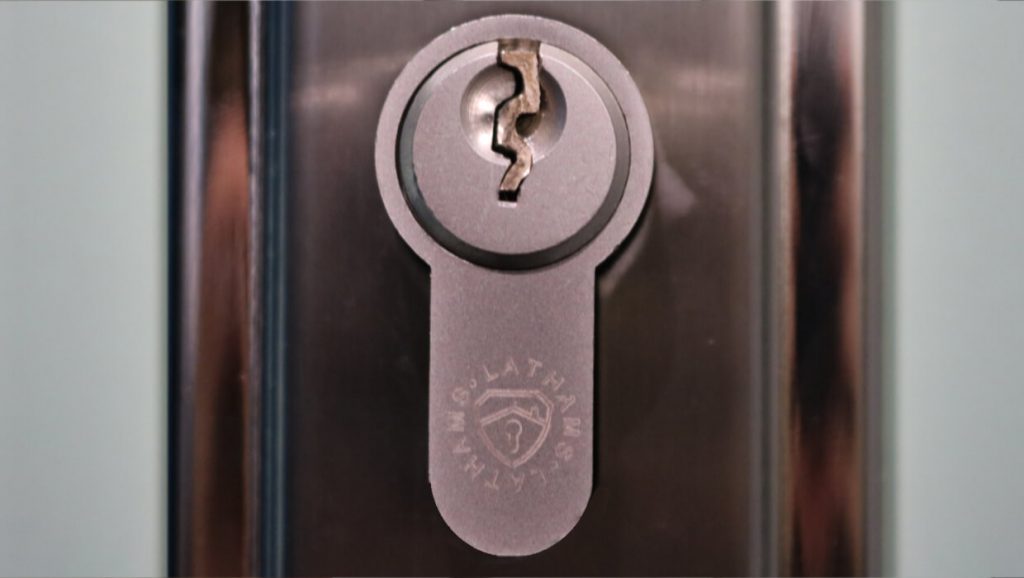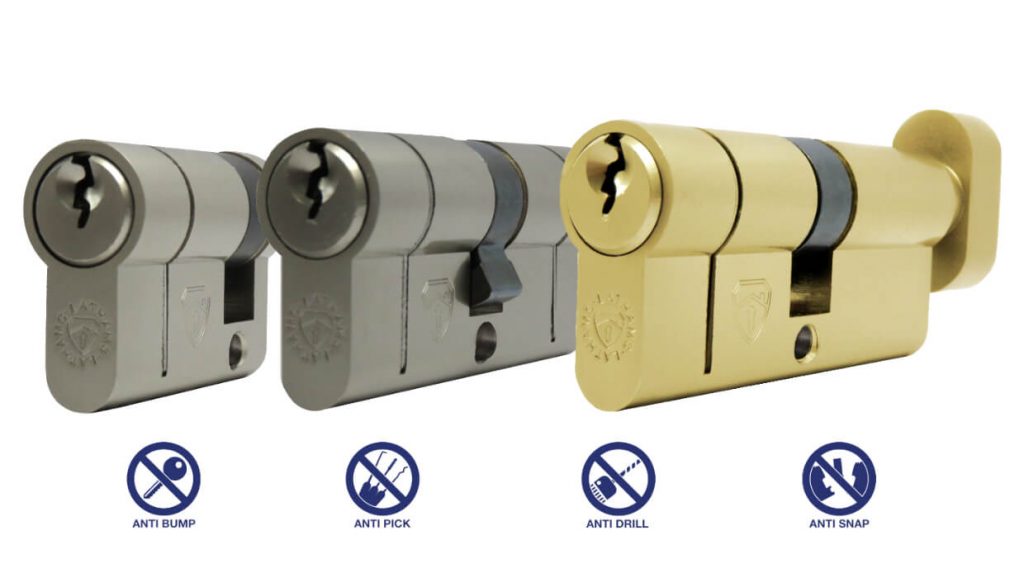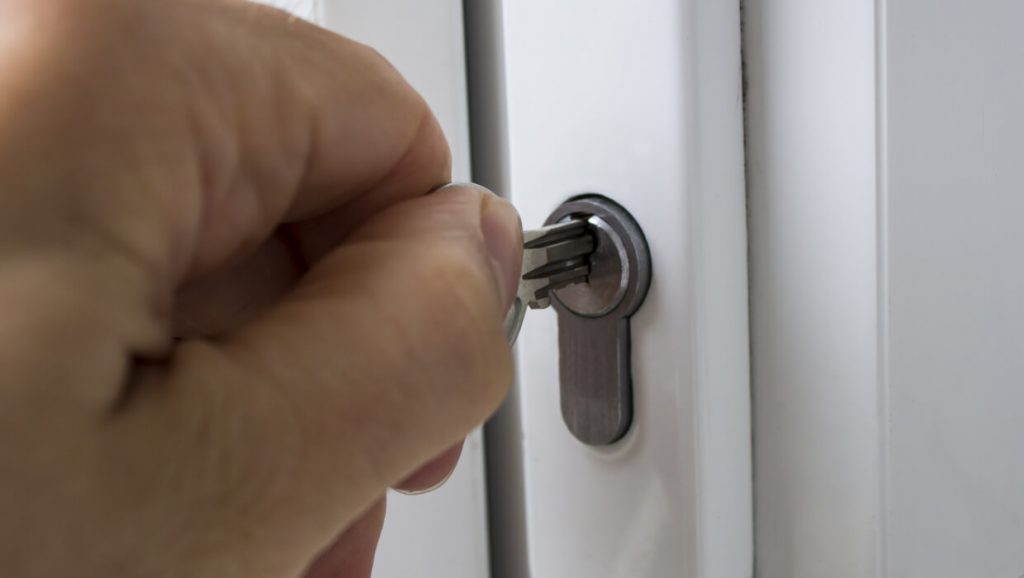A broken key in a lock can feel like an emergency. You may think your only choice is to call out a locksmith which is likely to cost you upwards of £70 plus any new hardware that you need. In most cases, however, you should be able to resolve the problem yourself, quickly and cheaply, with a few household items.
Why do keys break in locks?
A key might break in a lock for a number of reasons. Firstly, the key itself might have weakened over time making it more likely to snap when being turned, especially if done so with excessive force. Alternatively, it may be that the lock is faulty or it’s mechanism has become clogged up with debris. We’ll take a look at some of the common issues for keys breaking into locks and how to prevent these from happening.
A Weakened key
What are keys made of?
Keys are usually made from brass, soft metal and aren’t as strong as we might assume. Being made from a soft metal allows key cutting to remain cheap as well as much easier to alter if the first cut didn’t quite fit the lock it was made for. Most importantly, manufacturing keys using soft metals makes them much less likely to damage the door lock as you insert it.
What causes the key to weaken?
As keys are made from soft metals they are prone to damage for seemingly innocuous uses beyond their intended purpose. For example, using your key to open parcels or tins of paint is likely to wear the teeth down and leaving the key in your back pocket or loosely “knocking around” in your bag can cause stress to the body making the key bend. When your key is damaged, it’s much more likely to break off or get stuck inside your lock.
Only use keys for what they are intended for and try to keep them locked in smaller compartments within your bag so that they don’t travel and “bounce around” too much. If it’s hot, don’t leave them in direct sunlight and try to prevent sitting on them by not putting them in your back pocket.
What causes a door lock to weaken?
Locks will typically weaken due to a poor installation, extreme temperature changes, a buildup of debris in the internal mechanisms and/or rough key handling. To keep locks working smoothly we’d recommend lubricating them at least once a year. Contrary to popular belief, do not use something like WD-40 for doing this. WD-40 is a solvent, not a lubricant, and may remove any lubricant already in the lock cylinder. You should instead use a lubricant that is Teflon, silicone or graphite based such as Du Pont Multi-Use.
If you suspect your lock isn’t working as smoothly as it should, we recommend replacing it sooner rather than later to ensure you don’t run the risk of breaking your key in the lock or, worse, a break-in occuring.
If you aren’t sure which lock you need, check out our article on the most common types of lock and which doors to use them with. If you know which lock you need, check out our quality range of locks here.
Too much force
If you’re in a rush, you’re carrying other items like shopping bags, or you have a stiff door lock (which you should be replacing), you are likely to apply excessive force to your key whilst trying to open your door. Use your key correctly without too much force, and minimise risk of your key getting stuck in the lock half turned.
Why has my key become stuck?
How far the key has turned before becoming stuck can give you some insight into the problem:
Key won’t turn in lock
If the key has not turned at all then this is likely to be because you have tried to use the incorrect key or a badly cut, worn or broken key. Firstly, try a different key and, if you’re certain it is the correct one, lubricate the lock using a Teflon, silicone or graphite based lubricant as discussed above (not WD-40). If the key still won’t turn, and it’s been recently cut, take it back to the key cutters to redo. If it is not a recently cut key, this could be a sign you need to replace the lock.
Key is stuck and is half turned
If the key isn’t turning in the lock, but has partially turned prior becoming stuck then this may indicate lock failure or incorrect operation of the lock. Again, this may be a sign you need to replace the lock.
In both cases, do not keep forcing the key otherwise you run the very high risk of breaking the key inside the lock.
What not to do when your key breaks inside a lock
If your key has broken off inside your door lock it can be tempting to keep pushing in an attempt to force the lock open. This is likely to cause more damage than good and leave your key stuck even deeper within the door lock, making it harder to remove even for a professional locksmith.
How to get a broken key out of a lock
If your key is stuck inside your door lock, there are some simple household items you may be able to use to retrieve the broken key yourself which are listed below. If the key is particularly jammed or you don’t have access to these items, we’d recommend calling a locksmith.
How to get a broken key out of a lock yourself
First, spray the lock with a solvent such as WD-40, which will act as a slippery coating inside the lock and help make removing the key easier (please note – do not use WD-40 to maintain your lock. This is purely to help get the key out). Next, slip a thin tool such as a jigsaw or hacksaw inside the lock opening and drag the broken portion out.
Tip: Breaking the front end of the saw makes it easier to fit it inside the lock and use it to get the broken key out.
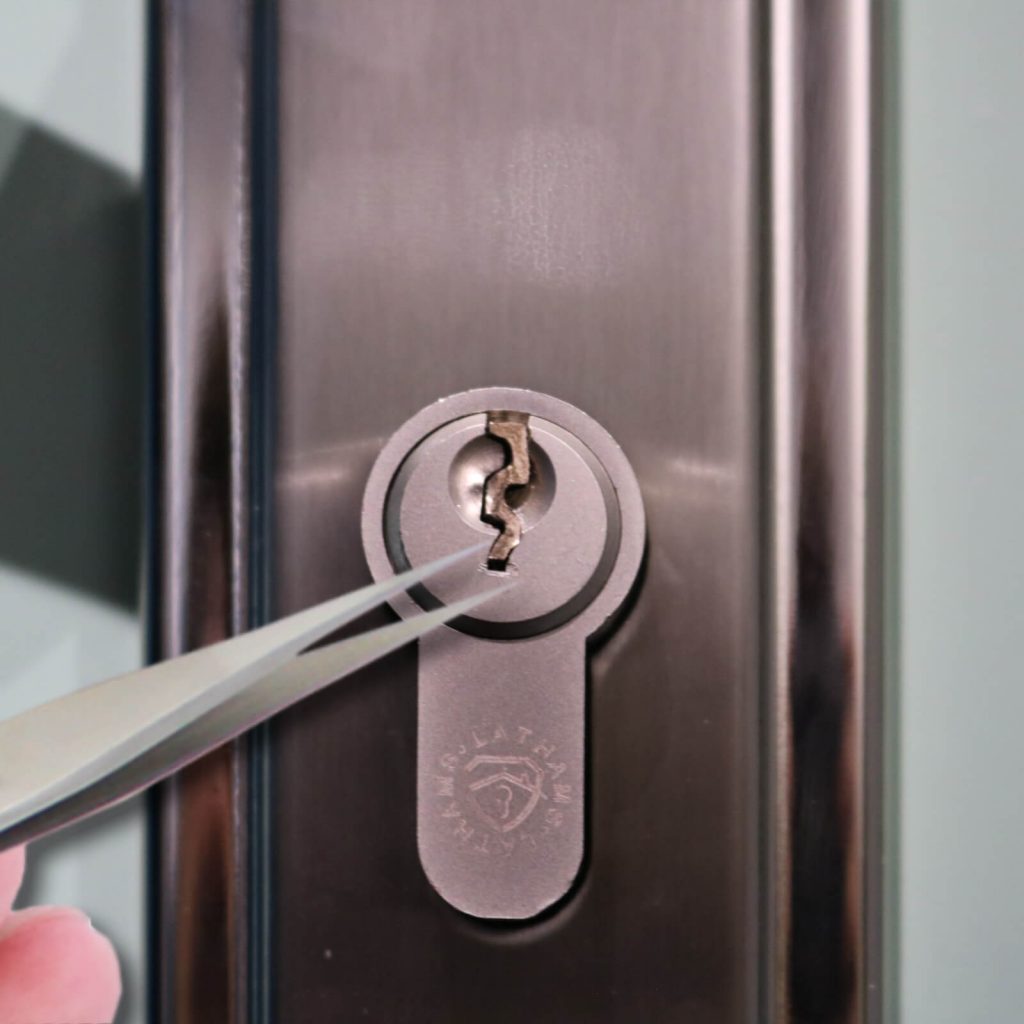
If you don’t have a jigsaw or hacksaw, simple items likely to already be in your home can be used to remove a key which has broken off inside a lock:
- Tweezers
- Bobby pin or safety pin
- Steel wire or paper clips
- Swiss army knife
If the key is still clearly visible and slightly protruding from the lock you can use superglue, as a last resort. Superglue a longer item to the exposed end of the key using this as a handle to pull the key free from the lock once the glue has set.
Important: This only works if you can still see the key.
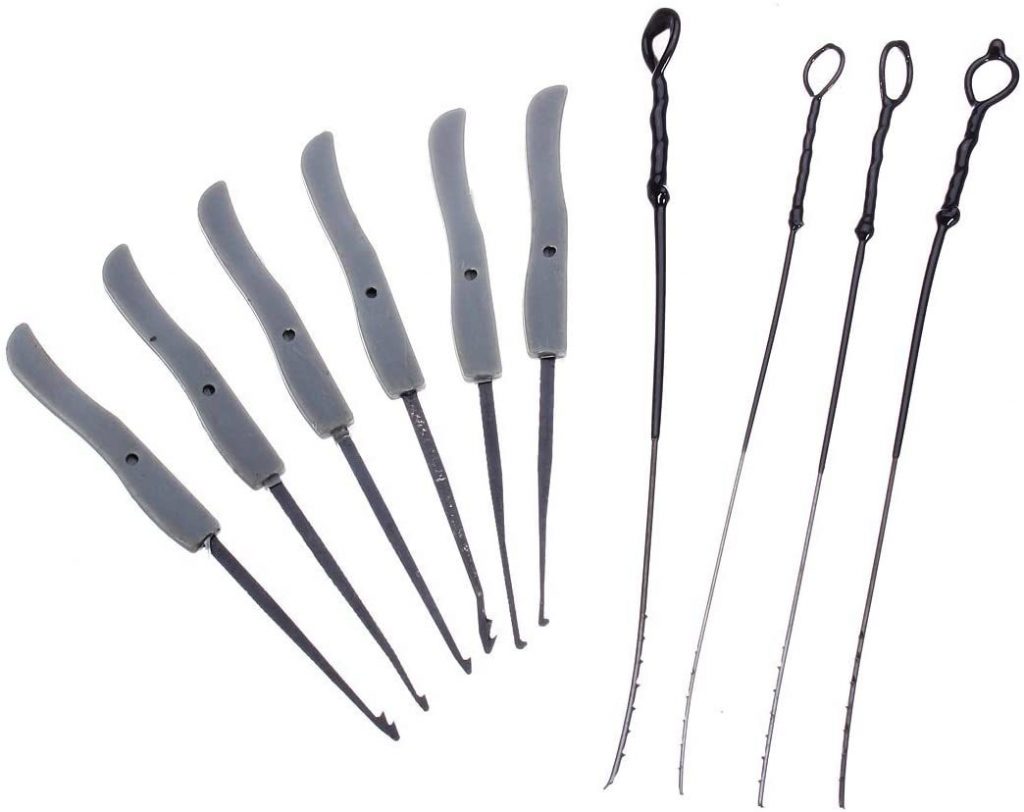
Using a broken key extractor
A broken toolkit will usually be used by locksmiths for removing broken keys or foreign objects from inside lock cylinders.
Broken key extractor tool kits can be purchased from a hardware store and on Amazon for around £5. Ordering a broken key extractor online may not be a solution this time but could be worth having in your home for the future.
When to call a locksmith
More complicated locks will require an expert locksmith to remove the broken key, to prevent damage to your lock and door. A locksmith will be familiar with many different types of locks and will know the quickest and easiest way to remove a key that has broken in your door lock.
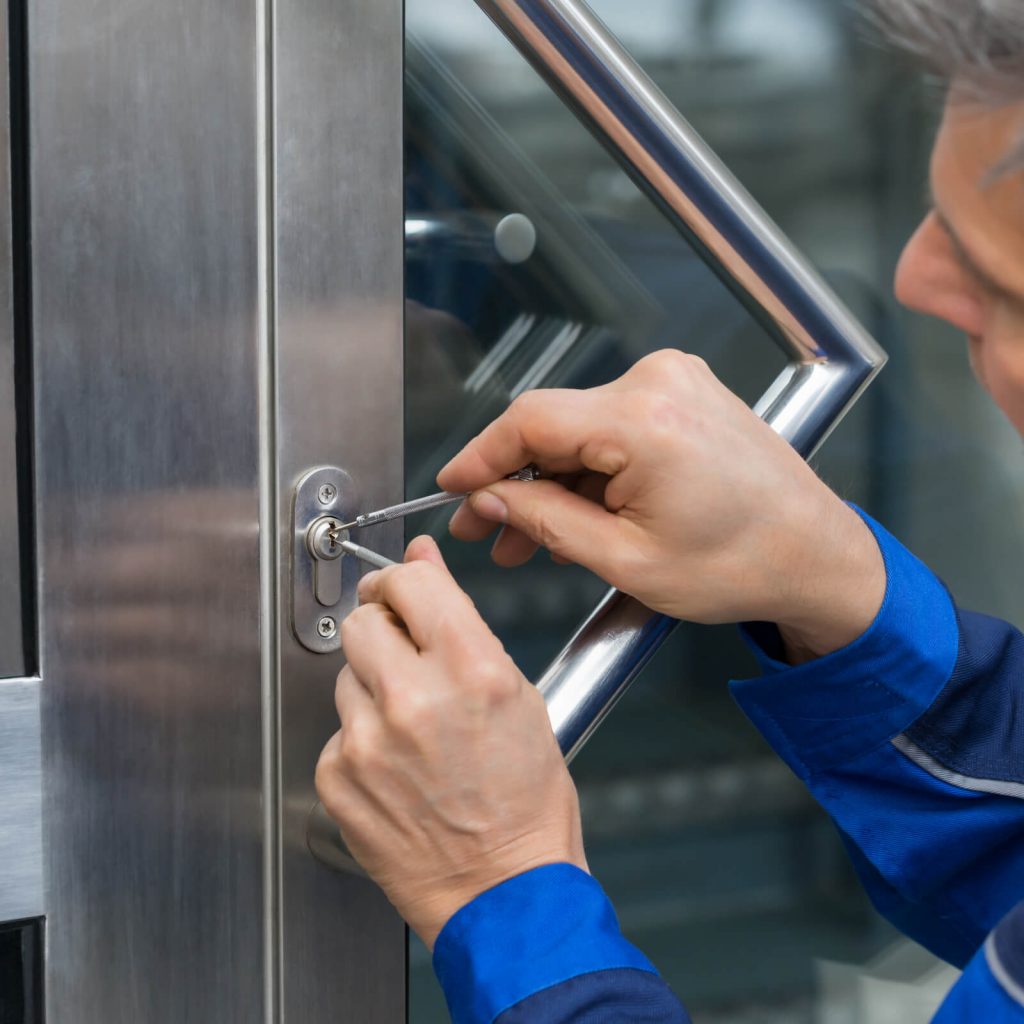
Call a locksmith if:
You are in a hurry
Locksmiths remove hundreds of broken keys all the time, and will be able to remove them quickly and time efficiently.
You are unsure how complex your lock system is
Trying to remove a broken key from a lock yourself could cause the pins and mechanisms within a lock can become damaged if you aren’t careful.
You are unsure how to extract the broken key using the tools above
Relying on a professional locksmith is the only way to guarantee the key will be removed correctly and proper lock function is maintained.
Ultimately, a broken lock affects your home security and leaves you vulnerable to break ins. It is crucial to get it fixed and working effectively as soon as possible, whether you are able to do this yourself, or have to call someone else.
Purchasing a new lock
Once you have successfully removed the broken key from your lock, it is likely the process will have damaged your lock. Consequently, it is best practice to change your locks so that the integrity is kept intact and your lock is secure as before.
There are many different types of lock you may consider, remember to choose one keeping in mind its security and accessibility features. In addition to these, having locks with multiple spare keys makes it easier to open a door in case you lose a key or your key snaps.


